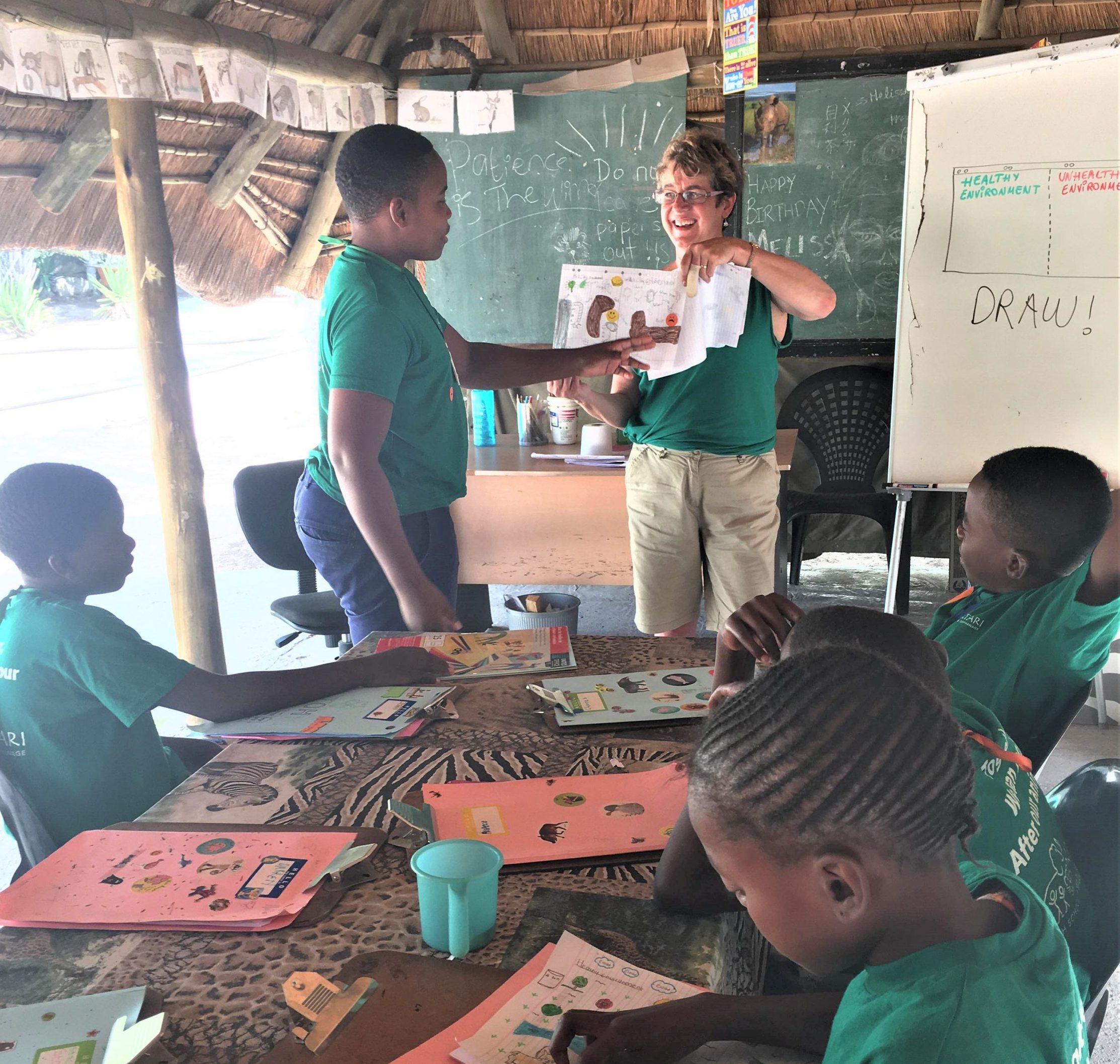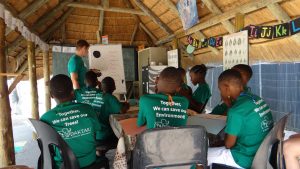
A Day in The Life of a Volunteer
The volunteer day begins
6:00 am!! The alarm wakes us. Although the sun is up and the daylight is a more gentle reminder that the day in the life of the volunteer is about to begin.
The air is already warm – no debate about what to wear this morning. Shorts every time. And Daktari supply the volunteers with standard issue T shirts, so that makes dressing the top half nice and simple too.
We dress and head out for tea and coffee to kick start the wakening process. Some mornings Rosie and I are first into the Lapa. The second week would often find the children are already there, quietly drinking mugs of tea and coffee too. There is a really noticeable maturity in these boys and girls, in stark contrast to the group the week before – yet most are less than a year or so older in age. I lost count of how many mornings last weeks group had to be reminded that “dog walk at 7:10 am means arriving on time with closed toe shoes on” ready to take the owners dogs for a walk. Let alone be down early enough for tea.
Dog walk
 Dog walk is a leisurely stroll for 10-15 minutes outside the camp to allow the dogs to complete their morning constitutional! Every volunteer and child goes. A hand slips into mine as one of the girls comes along to chat. They are inquisitive. They like to know about us. And we love to know about them too. One has dogs. Another has chickens. Most have siblings. One has a birthday next week. They normally walk to school for a 7:45 am start each day. Some take 15 mins, some take longer.
Dog walk is a leisurely stroll for 10-15 minutes outside the camp to allow the dogs to complete their morning constitutional! Every volunteer and child goes. A hand slips into mine as one of the girls comes along to chat. They are inquisitive. They like to know about us. And we love to know about them too. One has dogs. Another has chickens. Most have siblings. One has a birthday next week. They normally walk to school for a 7:45 am start each day. Some take 15 mins, some take longer.
As we round Martin’s enclosure they all peer into the distance to see if the cheetah is there. Dongo the wild dog does his usual pacing the perimeter. Kenzo (the dog) barks furiously at him. Really? Because you are never going to win that fight, fella! Sometimes the route takes us by the animal cemetery where we explain to the children the importance of burying our animals when they die and not just discarding them under a bush.
Then in no time at all we are back at the gate and my tummy is ready for breakfast.
Breakfast is in the Lapa
A communal area at the centre of camp. The “kids” have their own table to dine. The volunteers and owners have another. Cereal, granola, yoghurt, fresh fruit, and toast with a curious selection of toppings. All consumed under the watchful eye of Thor, the Marmoset. Watch out! He is faster than light. And persistent. Perching on a shoulder, wrapping himself under your chin, until he can grab some of your breakfast. Staff, meanwhile, prefer to take themselves into the Boma for theirs. Perhaps eating different to the rest. Or perhaps to escape Thor and his willful ways ????
After breakfast there is just enough time to brush your teeth before we begin stabling. Stabling means cleaning out the various animal enclosures, scrubbing their feed and water stations and then sweeping away any remnants of food, poop, feather, and leaves. Ready to start the day with a clean and tidy home again. We can all relate to that. Breakfast is served. Animal Kitchen is in the Boma and is where all the prep is done – fruit, veg, worms, meat, human kitchen leftovers for Molly the bush pig. Chopping, measuring, dishes being dispatched. It’s all go! Volunteers, staff and children working together. It can take anything up to an hour to get round all the accessible enclosures.
Some however, like Martin the Cheetah, have their own special routine! By now the sun is already in full bloom and the sweat is already literally pouring down my face from sweeping, bending and scrubbing.
Lessons
Lessons restart again at 2:00 pm until 4:30 pm.
The teaching programme is full.
Absolutely packed with knowledge to be transferred. And each day is different. Monday is all about setting the scene; choosing their leader; respect and politeness. Making their please and thank yous second nature. Then it’s onto an animal tracks lesson. Tuesday is a very “theory heavy” day which demands full concentration. It’s all about the Environment followed by animal knowledge and identification followed by a very hard hitting lesson about poaching.
all about setting the scene; choosing their leader; respect and politeness. Making their please and thank yous second nature. Then it’s onto an animal tracks lesson. Tuesday is a very “theory heavy” day which demands full concentration. It’s all about the Environment followed by animal knowledge and identification followed by a very hard hitting lesson about poaching.
Then, for some light relief, it’s rounded off with a little night safari. A walk around around the camp enclosures by torchlight to, hopefully, catch a glimpse of those nocturnal animals usually snoozing in their beds during the day.
On Wednesday the format shifts towards planning for their future careers, with a chance to consider jobs they may like in a Game Reserve. And best of all, a bus ride out to experience a safari lodge first hand and meet some of the staff who work there. The afternoon tests their animal knowledge by finishing off with a fun treasure hunt style quiz. That evening they (me too) are in for a wee treat as we get to watch the Lion King. Popcorn and all!
Then Thursday they get to experience walking in the real African bush, putting their knowledge to the test again as they identify tracks of leopard (yes there are leopard in this reserve), giraffe, impala. That’s followed by a round up of what Wednesday’s activities taught them. Well you didn’t think a day trip and a film were just for fun did you? Surely? And then their final structured lesson “Making South Africa a better place” tests how much they have really absorbed in the week. At the end of which they get to make their promises to show their commitment to making a change.
Friday there are no structured lessons as they prepare to leave at around 11:30 am. But more about that another day..
Stabling and social talks
At 4:30 pm we break for another bout of stabling. Temperatures regularly hitting mid to high 30s means the animals water bowls and troughs need topping up. Plus it’s their teatime too. Afternoon stabling complete, it’s time for everyone to grab a quick shower before the social talk at 5:30 to 6:30 pm when dinner is served.
Social talks cover everything from respect and politeness (because you can never have too much of a good thing), to substance abuse and safe sex. A really eye opening selection of topics which tests us as role models too. These are not lessons but discussion groups, in confidence, where the kids can begin to learn more about the effects of the choices they may make in life.
And as if that isn’t enough to keep us busy then there are two opportunities each week to teach at Eco Club with Sara, the Outreach Manager. These are two lessons, taken out to local schools, to help engage the bigger classes in the environment and its better management. This takes you out of camp for the afternoon. It’s a really interesting experience. It is also challenging as you can read on blogs Schooling in real South Africa (Rosie’s Story) and Schooling in real South Africa (Marie’s Story)
Many hands make light work
And still the day isn’t full enough! Generally lessons are led by two volunteers, which leaves those remaining to help out with the building, “big clean”, and maintenance chores for the animal enclosures. So anyone not on class is expected to go and find Marina, the Animal Manager Assistant, and see what today’s tasks are and to help her. So there is always something needs to be done.
And so to bed
On reflection
I wonder how those who choose to be a longer term volunteer will make that adjustment…..
She Wordsmiths..
A Day in The Life was first published in February 2018 at Bush Hearts and Minds which charts the story my friend and I volunteering in South Africa. An amazing experience and one which will stay with me forever..






